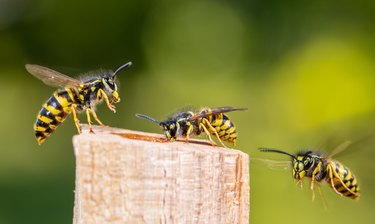
The earth is full of fascinating creatures, and one of them is the yellow jacket. Even though they can be frightening because of their painful sting, they're essential to the planet and its ecosystems. Yellow jackets are pollinators, and we need them to sustain our food supply. It's important to understand yellow jackets, including what they are, how long they live and why they are so important. Hopefully, you'll come to appreciate them and let them thrive while staying safely away from their stinger.
What Is a Yellow Jacket?
Video of the Day
Technically, a yellow jacket is a type of insect. Is a yellow jacket a bee? It's a social wasp, although yellow jackets are pollinators, unlike many other types of wasps. Yellow jackets are often confused with bees because they are yellow and black. You can distinguish yellow jackets by their segmented body that is divided by a narrow waist.
Video of the Day
There are many species of yellow jackets found worldwide, and 16 of them are present in North America. Some form nests in the ground, and others make aerial nests. They're social animals and form communities every spring. Only the female queen survives through the winter to start a new hive the following year.
Yellow jackets eat a variety of foods. They prefer sugary nectar from flowers and fruit but settle for sugary human food, like soda, birthday cake or battered foods. The larvae need animal protein, and adult yellow jackets carry it back to the hive. By doing so, they help control the pest population.
How Long Do Yellow Jackets Live?
The life span of a yellow jacket is similar to the life span of a wasp. Worker yellow jackets only live between 10 and 22 days, while the queen can live up to one year. The queen mates and keeps the hive populated.
Do yellow jackets die in the winter, or do they hibernate? Only the queen hibernates through the winter, while the remaining workers die in the first frost. The queen hibernates after mating so she can start a new hive in the spring. She usually rests inside natural material shielded from weather extremes, such as an old log or inside a thick pile of leaves.
In the spring, she emerges and builds a nest for her young family. Once the nest is ready, she lays eggs and feeds the larvae plenty of protein. Once they hatch, she lays more eggs, and each generation helps care for the next until the first frost.
The Yellow Jacket Queen and More Facts
Each hive has a single yellow jacket queen, and she is essential to everyone's survival. The queen yellow jacket is the only one that can lay eggs and reproduce, and she ensures the survival of the species through bitter winters. During the late summer and early fall, yellow jacket queens produce larvae that are also capable of reproducing. Once those eggs reach adulthood, they depart so the population can grow the following year.
Contrary to popular belief, yellow jackets aren't aggressive unless they believe their hive is being threatened. That's why it's so critical that you do not attempt to deal with an infestation of yellow jackets yourself. Call a professional who can try to relocate the hive somewhere safe for both pollinators and humans.
If you're stung, look for the stinger and remove it if it's there. Clean the wound and apply an antibiotic ointment. Keep the spot elevated and apply ice or cold packs to alleviate pain. If you experience anaphylaxis, call 911.